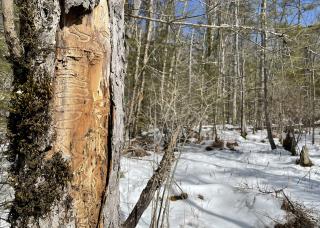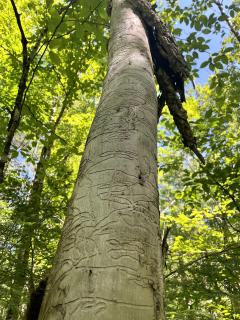Tribes, Forest Service collaborating to offset invasive species effect on Native American culture

MAINE—USDA Forest Service is collaborating with tribal groups and other groups to offset some effects of the invasive insect emerald ash borer, which is devastating native black ash and disrupting Native American culture across parts of the eastern United States and Canada.
The emerald ash borer kills trees in the ash family in North America, especially brown ash, also known as black ash. The mortality rate of EAB-infested ash trees here is nearly 100%, with most infested ash trees dying within a few years.
The ash borer, native to Asia, is considered the most destructive invasive forest insect in North America. It was first detected on this continent in 2002 near Detroit and now infests ash trees in 36 states and five Canadian provinces. By 2035, EAB is expected to impact about 75% of the native range of black ash in the eastern United States and Canada.
Brown ash can be found in swamps, floodplains and riparian areas of forests. It provides habitat, food and other materials for wildlife and humans.
It is also considered a keystone cultural species for tribal nations of the United States and First Nations of Canada. These dire impacts to brown ash trees are especially harmful to Native American cultural practices, as tribes traditionally have used black ash to make baskets and other products for thousands of years.
“Biological invasion threatens keystone species indelibly entwined with Indigenous cultures“ was published in "Frontiers in Ecology and the Environment" earlier this year and provides more detail about this complex and far-reaching issue.
Les Benedict is a member of the Saint Regis Mohawk Tribe, located in upstate New York, and a co-author of the paper. He said, “Traditional stories from Ojibwe and Wabanaki (Maine Indians) tell of the importance of black ash. The Ojibwe tell of Black Elk and a sacred tree, black ash. Central to the Wabanaki creation story is brown ash, which they came from. These two cultural stories underline the cultural significance of black/brown ash and the relationship basketmaking tribes have with the tree.
“For multiple reasons, brown ash is central to Native American basketmaking. EAB is a direct threat to tribal cultural social structure. Basketmaking as an art form provides a sense of identity and self-expression. Moreso with the Anishinabek Tribes, tribal communities in the Great Lakes area,” he added.
The paper’s lead author, Nate Siegert, said they have explored some alternative materials for basketmaking, but culturally, there are no substitutes for black/brown ash. Siegert works out of the Eastern Region State, Private, and Tribal Forestry Field Office in Durham, New Hampshire.
Tom Luther, a co-author of the paper and recently retired Forest Service geographic information system specialist, said they used GIS to model the expansion of EAB distribution throughout the native range of brown ash and quantify estimates of mortality over time. Luther said it is rewarding to use this technology to help mitigate EAB impacts and preserve the ash resource for future generations of Indigenous peoples.
EAB has other consequences as well. “We looked at impacts to hydrology, forest diversity, as well as social impacts,” Benedict added. “If you suddenly lose a species, it opens the pathway to several invasive species. A lot of that has been well studied by researchers from Michigan State University.“
The Forest Service, Michigan State University, University of Maine, University of Vermont and State University of New York-ESF are investigating socioeconomic and other impacts.
Benedict added, “I’m speaking from the perspective of New York state tribes and of our desire to increase awareness, engage the basketmaking community, and to preserve ash. We are networking with the Senecas, Onondaga, Cayuga, Tuscarora, Oneida and Mohawk, located in New York and across Ontario and Quebec. Those names are representative of the Iroquois Confederacy, which was established long before the first European settlers arrived.
“We’ve been working with them on outreach and awareness. We’ve also been working internationally with the Algonquin Tribes in Ontario and the Abenaki Tribes in Quebec on this,” he said.
University of Maine has been hosting a series of workshops on preserving brown ash to identify locations of ash so they can collect seed, Benedict added. They also work with seed savers, and they are developing their abilities to maintain ash and to collect and store seeds for the long term. There is also a surveillance program in place to monitor for EAB.
Tribes have been exploring replacement materials for brown ash for some time, long before the arrival of EAB in North America, Benedict added. “There are historical references and artifacts in Ottawa that have representative samples of baskets made with hickory, maple and, perhaps, oak as other materials that have been used.”
“They know the impact is coming, but they’re trying to minimize impacts,” Benedict said.


